In 2025, selling car parts online via dropshipping has shifted into high gear. Auto parts are an evergreen niche with booming demand, high margins, and a massive customer base of drivers, mechanics, and hobbyists. Whether it’s replacement brake pads or custom LED headlights, people are increasingly turning to e-commerce for their automotive needs. In this in-depth guide, we’ll explore why auto parts dropshipping is so lucrative, highlight the best suppliers and products, and share strategies to drive a successful automotive dropshipping business.
Why Dropshipping Auto Parts is a Lucrative Niche in 2025
The automotive aftermarket is huge and growing. Online sales of auto parts are accelerating year over year. In fact, the global e-commerce automotive aftermarket is projected to jump from about $96.8 billion in 2024 to $113.3 billion in 2025, a ~17% annual increase. By 2029 that online market is expected to double again to over $211 billion. This growth is fueled by the convenience of online shopping and an aging fleet of vehicles that need regular maintenance. As of 2022, there were roughly 290.8 million cars on the road in the U.S. alone, each containing tens of thousands of parts that eventually wear out. Every one of those parts – from oil filters to engine sensors – represents a potential sale for a dropshipper.
Demand is steady and evergreen. Cars aren’t going away, and neither is the need for parts. Most vehicle components require periodic replacement (think brake pads, tires, batteries) or upgrades. Many consumables like filters and wiper blades have to be bought repeatedly, giving this niche excellent repeat-purchase potential. Automotive products also span seasonal needs (wipers and all-weather mats in winter, performance parts in racing season, sunshades in summer), making it a year-round business. With millions of car owners worldwide – plus mechanics, DIY tinkerers, and car enthusiasts – the customer base is enormous. In the U.S., about 76% of commuters drive their own car, so virtually everyone is a potential customer for maintenance parts or accessories.
High-ticket products with healthy margins. Auto parts typically cost more than everyday consumer goods, which means higher profit per sale. It’s not uncommon for popular aftermarket parts (like performance filters or LED light kits) to retail for $50, $100, or far more. Dropshippers can take advantage of that spread.
Rise of DIY and online part buying. Another reason this niche is thriving: consumer behavior. More people are comfortable fixing or upgrading their own vehicles thanks to YouTube tutorials and forums. They go hunting online for parts and tools rather than paying premium dealer prices. E-commerce auto part sales have exploded because they offer quick, affordable access to what people need when something breaks. Instead of visiting a brick-and-mortar auto parts store, drivers can compare prices online and get parts shipped to their door, often within days.
Multiple revenue streams. Auto parts dropshipping isn’t limited to replacement components. You can also stock accessories and upgrade kits that appeal to enthusiasts (think custom alloy wheels, performance exhausts, smartphone integration gadgets, etc.). These tend to be discretionary purchases with passionate buyers, and often come with premium pricing.
Best Dropshipping Suppliers for Auto Parts (2025)
Choosing suppliers in auto parts isn’t just about who has the SKU—you’re balancing fitment accuracy, inventory depth, warehouse geography, shipping methods (parcel vs. LTL), pricing/MAP, returns, and integration. Below are vetted options covering global catalogs, US/EU distributors, powersports specialists, and dropship platforms. Start with one “primary” (broad coverage, automation) plus one “specialist” (performance/off-road/moto) to reduce stock-outs and widen assortment.
1) CJdropshipping (Global, Accessories + Selected Aftermarket)
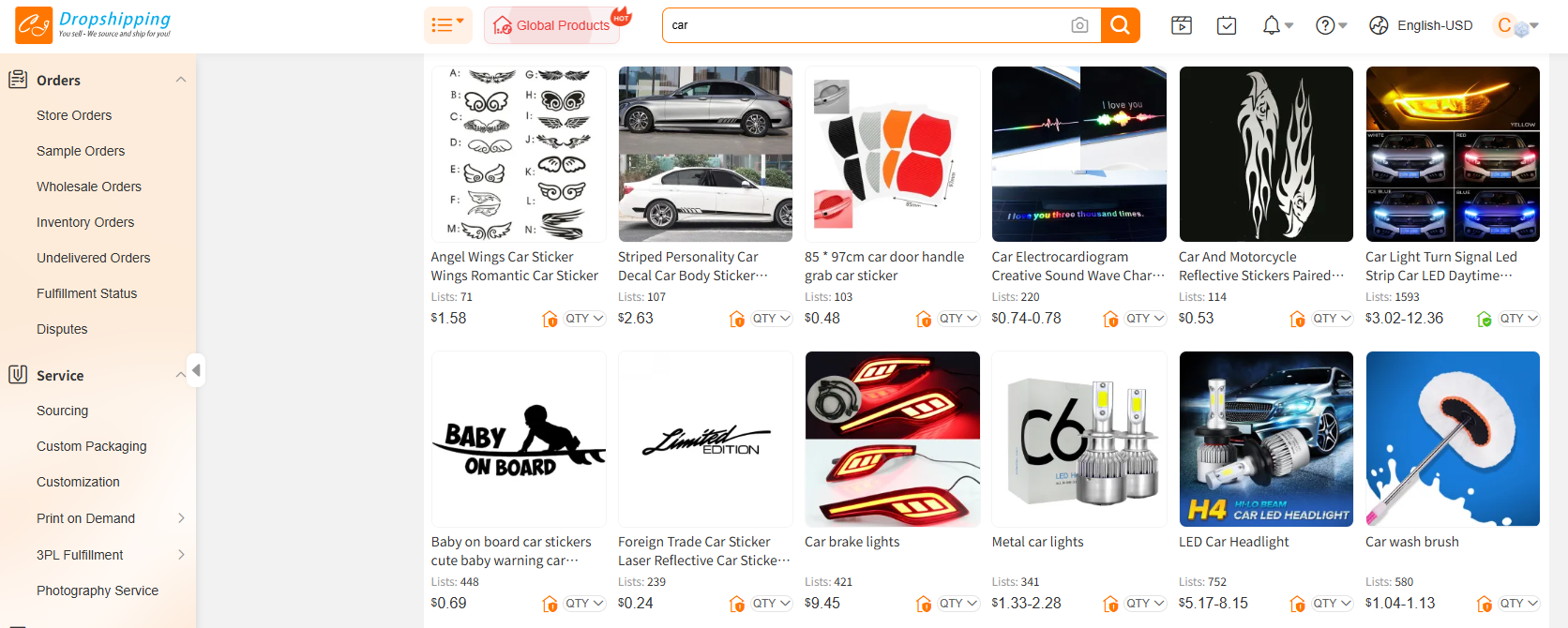
Best for: Wide accessory coverage, agile sourcing, US/EU/CN fulfillment, beginners who want one app to run sourcing → fulfillment.
Catalog & strengths: Broad auto parts dropshipping products , interior/exterior add-ons, lighting, electronics (OBD scanners, dash cams, chargers), organizers, detailing tools; growing aftermarket selection. Ability to source on request if you can’t find a SKU.
Warehouses & SLAs: CN main hubs + US/EU warehouses for many SKUs; typical 3–7 business days from local stock, longer from CN (line depends on route).
Tech & automation: Native Shopify/WooCommerce/Wix/BigCommerce apps, 1-click import, auto-fulfillment, tracking sync, order routing to nearest warehouse, SKU mapping; optional custom packaging/branding and product photography.
Pricing & fees: No monthly platform fee; pay product + shipping per order. Competitive accessory pricing; shipping varies by route/weight—check landed cost.
Returns & QC: Dispute process; photo/video QC options; blind shipping supported.
Why pick CJ: Fast to start, all-in-one (sourcing, local stock, branding, POD for merch), strong automation for beginners, good for high-margin accessories and “trend tests” before you commit to a US distributor.
Watchouts: For critical fit/mission-critical components (e.g., emissions/safety), verify brand and spec; confirm US warehouse stock if you promise 3–7 day delivery.
2) Turn 14 Distribution (USA, Performance/Aftermarket)
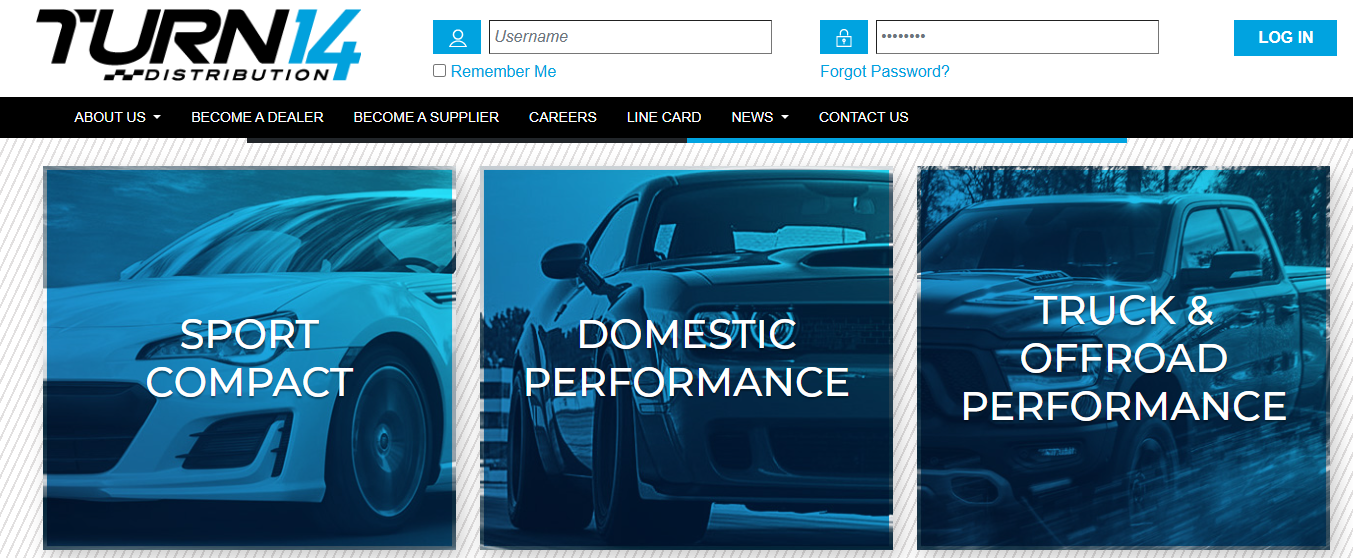
Best for: Performance and enthusiast parts with fast US ground (multiple DCs; PA/TX/NV).
Catalog: Suspension, induction/exhaust, brakes, wheels/tires (select), drivetrain; premier brands across JDM, Euro, domestic, off-road.
Ops & SLAs: Same-day shipping cutoff, 1–2 day ground to large parts of US; robust live stock feeds.
Tech: Dealer portal, robust inventory/price feeds (CSV/API/EDI via middleware), MAP monitoring.
Onboarding: Dealer application; business docs required.
Why pick: If your niche is tuner/off-road/performance, Turn 14 is a speed + depth anchor; high availability + brand credibility.
Watchouts: Enforces brand MAP; margins depend on brand tier. LTL/freight for bulky items—quote before advertising “free shipping”.
3) Keystone Automotive / LKQ (USA, Broad Aftermarket Replacement + Accessories)
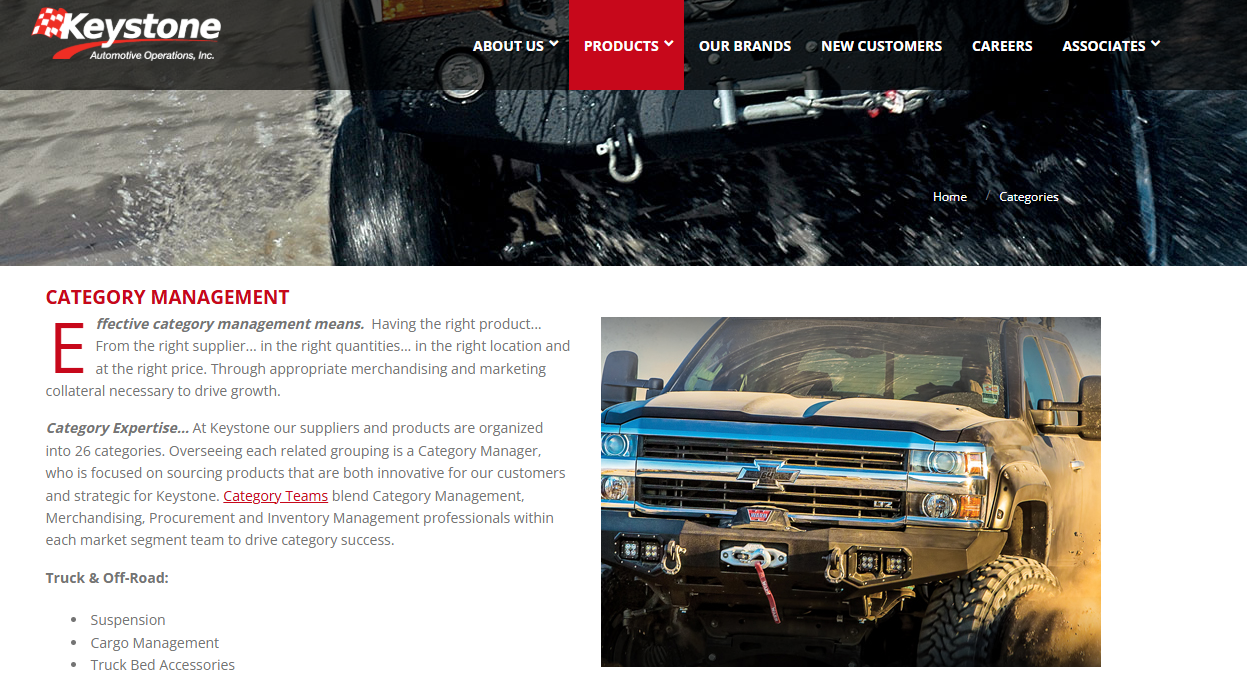
Best for: All-around coverage: body, mechanical, lighting, collision, truck/Jeep, RV, towing.
Catalog: Deep aftermarket replacement plus cosmetic/exterior lines; truck/upfitting (racks, bumpers, steps).
Ops: National DC network with strong ground reach; frequent restocks.
Tech: B2B portal, price/availability feeds; EDI options via integrators.
Onboarding: Dealer account; resale certs.
Why pick: If you want a single US distributor to cover the bulk of your mainstream aftermarket SKUs with dependable fill rates.
Watchouts: MAP on many lines; verify returns policy by brand (collision/body returns often stricter).
4) Premier Performance (USA, Trucks/Off-Road/Power)
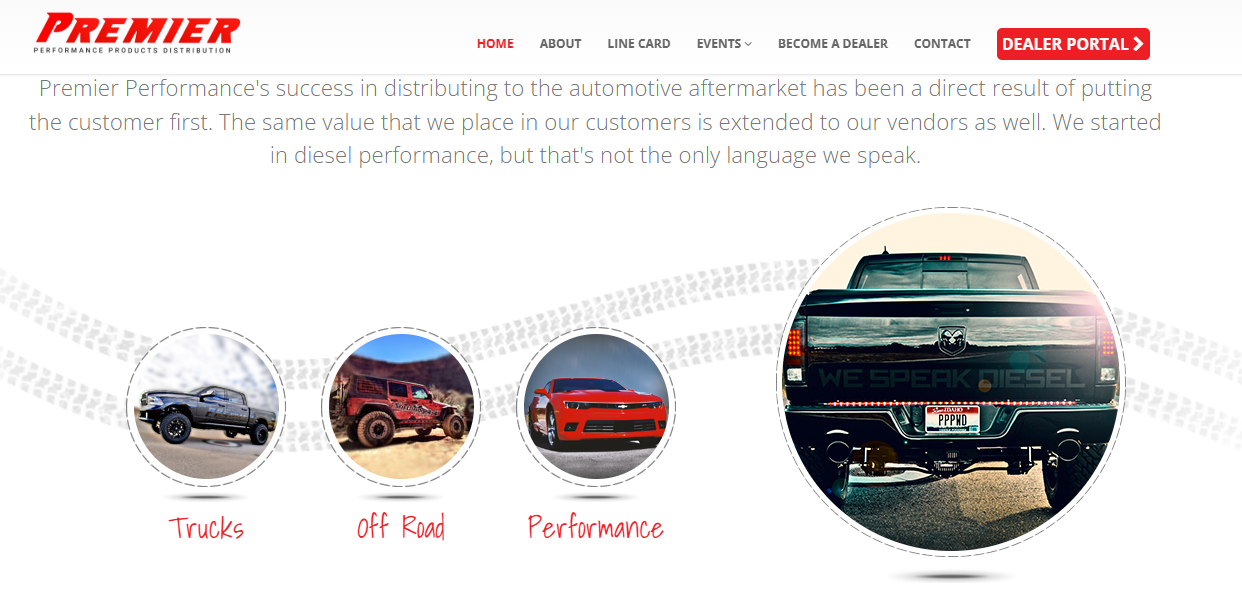
Best for: Diesel, truck, towing, off-road upgrades (Ford/GM/RAM), overland accessories.
Catalog: Intakes/exhausts/tuners (brand dependent), suspension/lift kits, tow/haul.
Ops: Multiple US DCs; strong truck specialty brands.
Tech: Dealer portal + feeds; MAP compliance tools.
Why pick: If your store focuses on truck performance and overlanding, this fills gaps general distributors miss.
Watchouts: Brand approvals and emissions compliance vary by state—control ad copy by region.
5) Motor State Distributing (USA, Racing/Track/Hot-Rod)
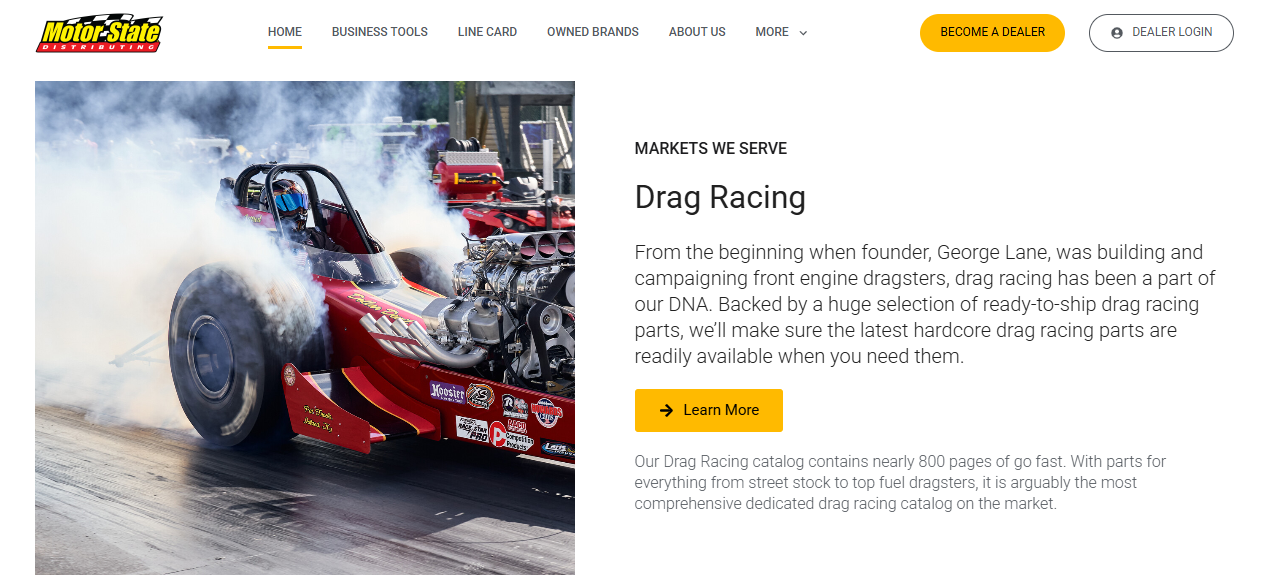
Best for: Racing, circle track, drag, hot-rod components and safety gear.
Catalog: Performance internals, fueling/ignition, safety (SFI), chassis & fab.
Ops: US DC with race-season throughput; dealer support.
Tech: Data feeds, portal; fitment often part-centric (not YMM).
Why pick: If you sell to motorsport customers needing weekend-race delivery and niche SKUs.
Watchouts: Specialized audience; content must be technical; returns stricter on race parts.
6) Meyer Distributing (USA, Truck/Jeep/Outdoor/Marine)

Best for: Jeep/4x4/truck plus lifestyle (outdoor, marine, RV).
Catalog: Bumpers, racks, winches, lighting, soft goods; wide accessory palette.
Ops: Large hub-and-spoke DC network; broad 1–2 day ground coverage.
Tech: Dealer portal, feeds, EDI via integrators.
Why pick: Great to round out off-road + lifestyle catalog with reliable ground speed.
Watchouts: Freight class items (bumpers/racks) → build a clear LTL policy and surcharge logic.
7) Parts Unlimited / Drag Specialties (USA/Global, Powersports & Moto)
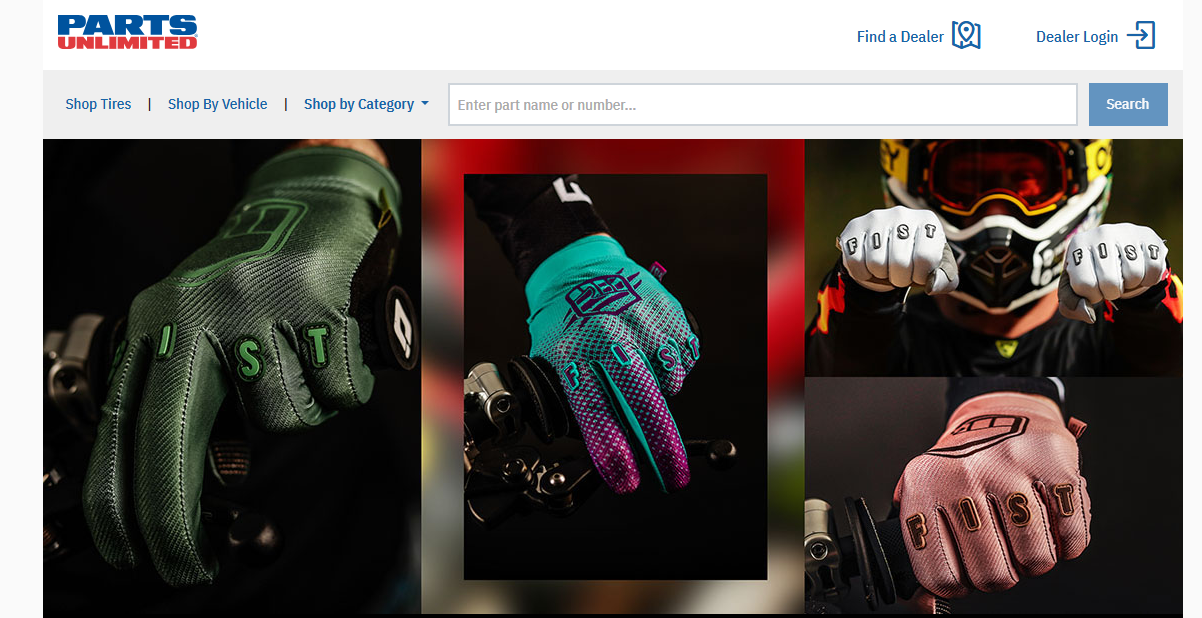
Best for: Motorcycle/ATV/UTV parts, apparel, and accessories.
Catalog: Helmets, tires, lighting, controls, exhausts, maintenance.
Ops: Global distribution to 12k+ dealers; quick US shipping.
Tech: Dealer portal; inventory feeds via partners.
Why pick: If you extend to powersports, these two are the cornerstone distributors.
Watchouts: Tire/wheel shipping surcharges; brand MAP common; seasonal demand spikes.
8) Spocket (Platform: US/EU Dropship Suppliers)

Best for: Fast US/EU shipping on accessories & light aftermarket without distributor contracts.
Catalog: Interior/exterior accessories, small tools, car-care; curated vendors with 2–7 day domestic shipping.
Tech: Plug-and-play Shopify/Woo/Wix; 1-click import, tracking sync, branded invoice.
Pricing: Subscription for access; wholesale costs vary by vendor.
Why pick: Ideal add-on for speed-sensitive accessory SKUs where you want simple onboarding and pre-vetted vendors.
Watchouts: Depth on hard parts is limited; cross-check vendor return terms and inventory volatility.
9) AliExpress / Alibaba (Global Manufacturers, Best for Accessories/Universal)
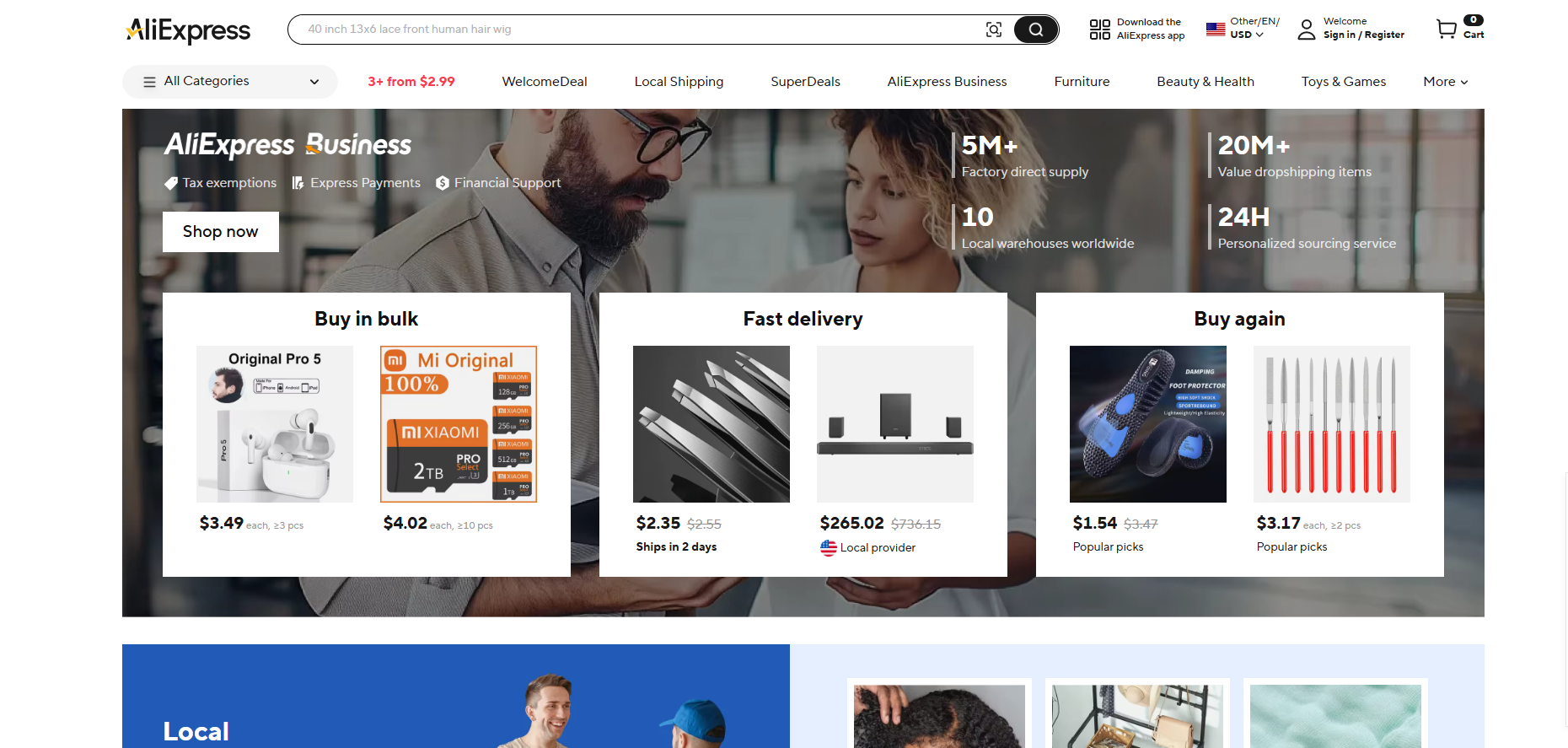
Best for: Testing trending accessories (lighting kits, organizers, electronics) with low MOQs; factory-direct.
Catalog: Massive; fastest to list and test. Many vendors now offer US/EU local stock on hot SKUs.
Ops: CN lines vary (10–20+ days), but local-stock SKUs can ship in 3–7 days.
Tech: Use import/automation apps (AutoDS/DSers) for price/stock syncing; sample first.
Why pick: Price advantage and rapid product iteration.
Watchouts: QA variability; avoid safety-critical components; IP/brand risk—sell unbranded or your own brand.
10) AutoZonePro / NAPA Commercial (USA, Local Speed & Consumables)
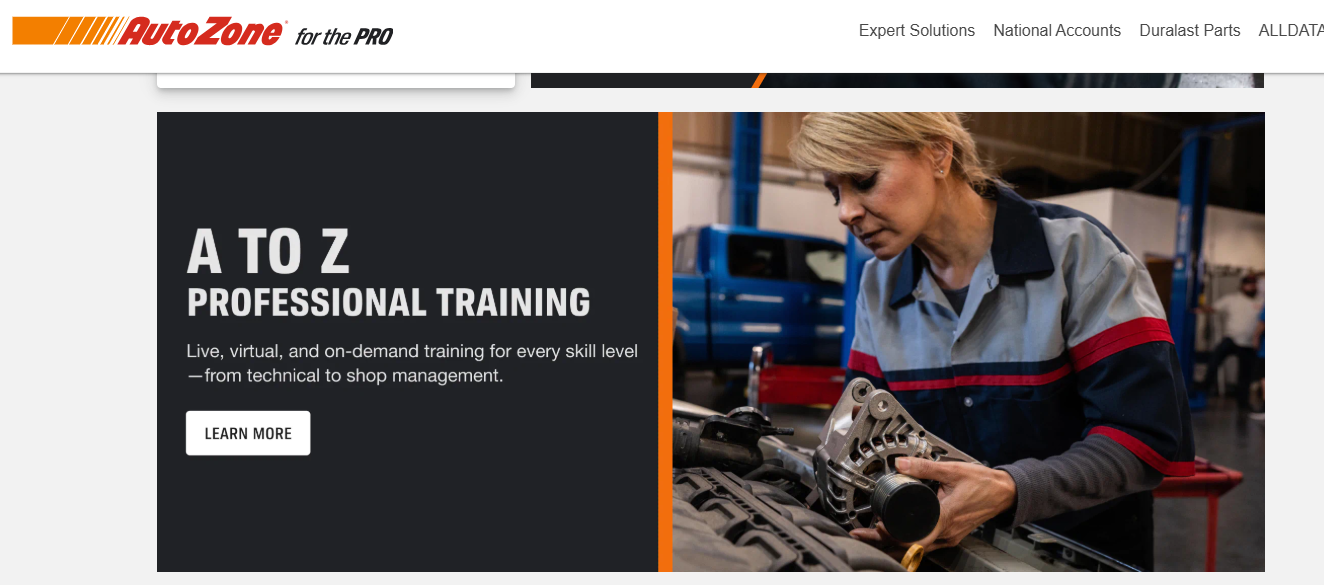
Best for: Consumables & common maintenance (wipers, filters, plugs, fluids) with same-day or next-day local fulfillment.
Catalog: Broad maintenance lines + select hard parts; trusted store brands + major labels.
Ops: Ship-to-door, BOPIS, or local delivery in many metros; great for emergency orders.
Tech: Commercial portals; basic data export; limited ecom automation.
Why pick: Reliability + brand trust; backup source to prevent stock-outs on essentials.
Watchouts: Not built for full ecom automation; margins thinner on commodity items.
Top Auto Parts & Accessories to Dropship in 2025
Not sure what to sell? The auto niche is broad, so it pays to zoom in on high-demand product categories. Below are some of the top-selling auto parts and accessories for 2025 and why they’re great for dropshipping:
1. Interior Protection (Seat Covers & Floor Mats)
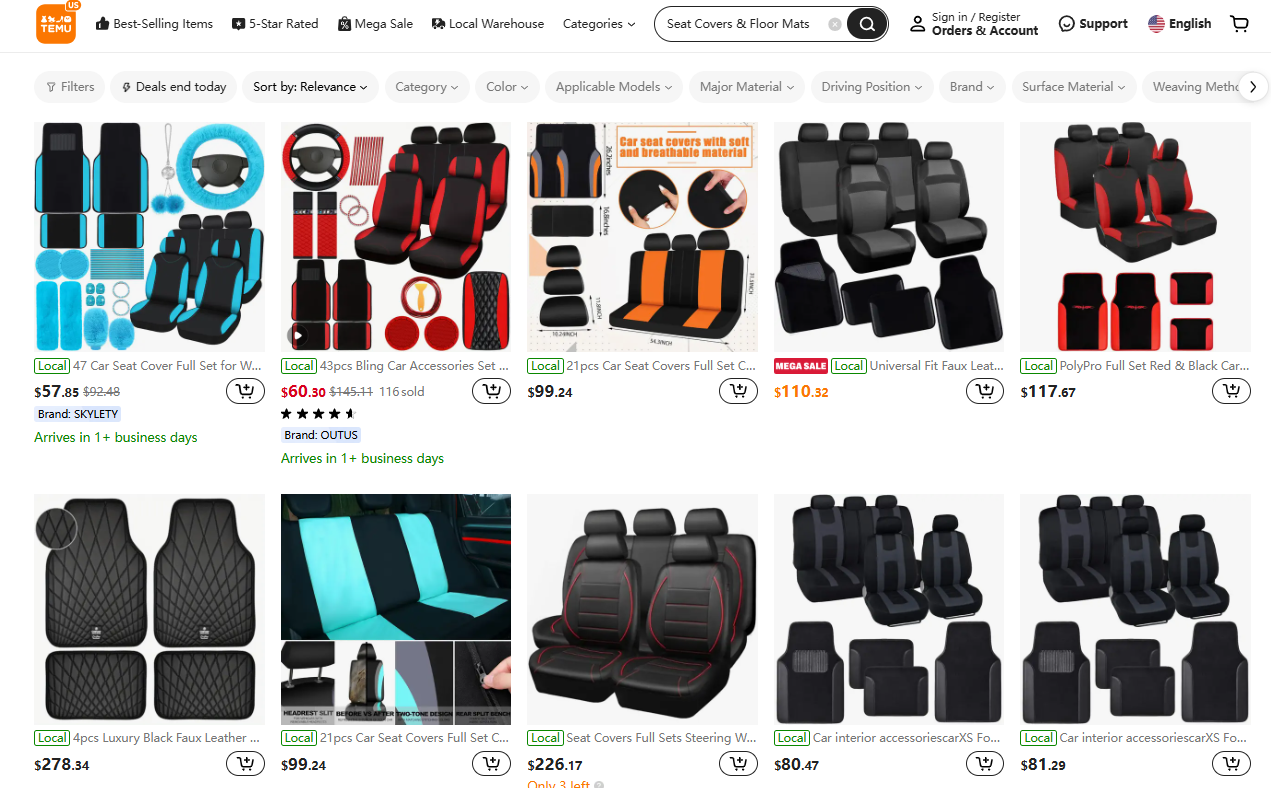
Car owners love to personalize and protect their interiors. Seat covers remain a perennial bestseller because they protect upholstery from wear and spills while offering style options. Likewise, heavy-duty floor mats (especially all-weather rubber mats) are in constant demand – drivers replace them when worn, and climates with snow or mud drive seasonal spikes in sales. These products are relatively inexpensive, come in universal sizes or model-specific fits, and are easy to ship (rolled or folded). Why sell them? They have broad appeal (virtually every car owner can use them), and they’re often bought in sets, increasing order value.
2. Steering Wheel Covers

A simple accessory that improves grip and comfort. Steering wheel covers sell well year-round, with bumps in summer (to keep wheels from getting too hot) and winter (for a warmer touch). They come in countless styles – from plush covers to performance grips – appealing to both casual drivers and enthusiasts. Like seat covers, they’re universal-ish in sizing and easy to stock via dropshipping.
3. Maintenance Essentials (Brake Pads, Filters, Wipers)
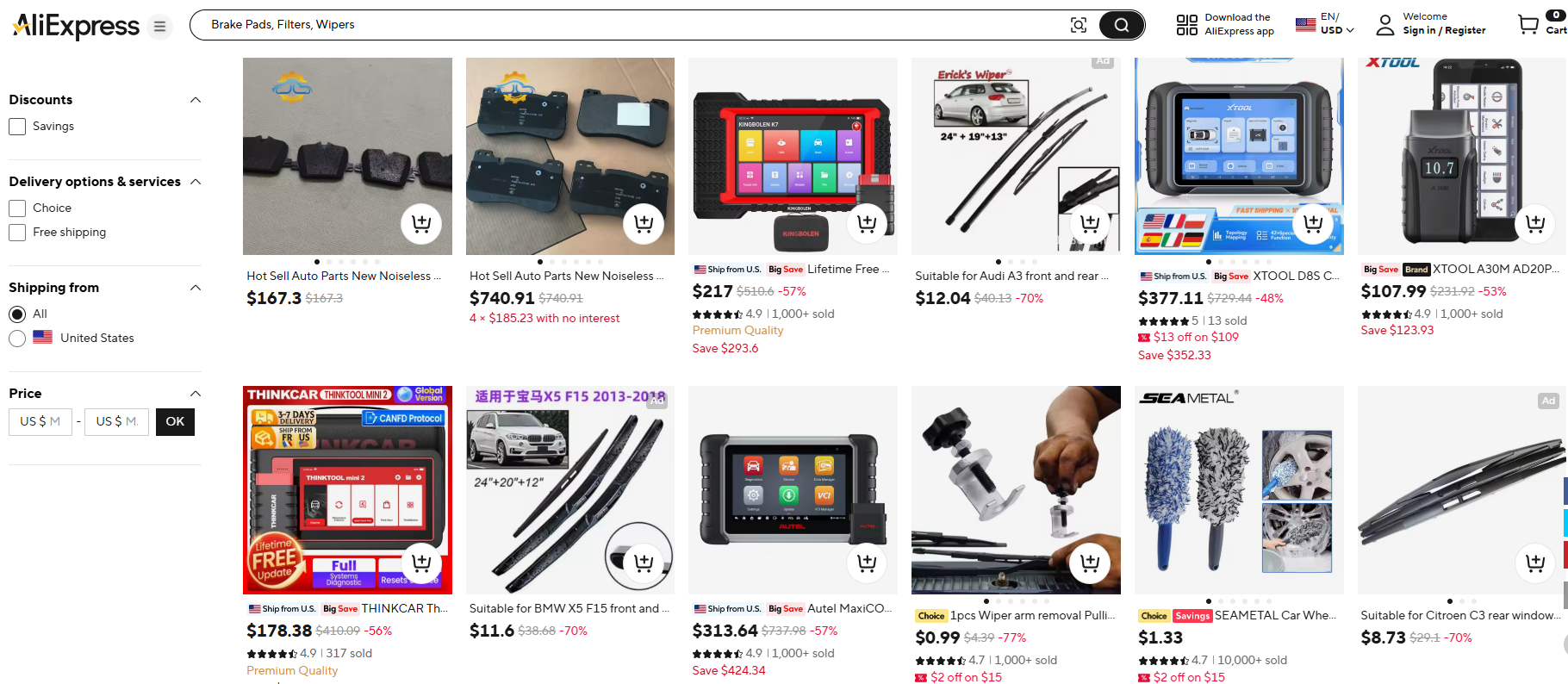
Critical replacement parts such as brake pads are always in demand for the DIY maintenance crowd. While not everyone will change their own brakes or oil filters, many cost-conscious car owners and local mechanics look for deals online. Dropshipping brake pads, spark plugs, air filters, and windshield wipers can be lucrative if you partner with suppliers providing trusted brands or quality aftermarket alternatives. These items move steadily because they wear out on regular intervals (e.g. wipers yearly, brake pads every 20-50k miles). Ensure you provide detailed compatibility info (year/make/model) so customers get the right fit – when you do, you tap into a recurring revenue stream since buyers will return for the same part again and again.
4. Car Electronics & Gadgets
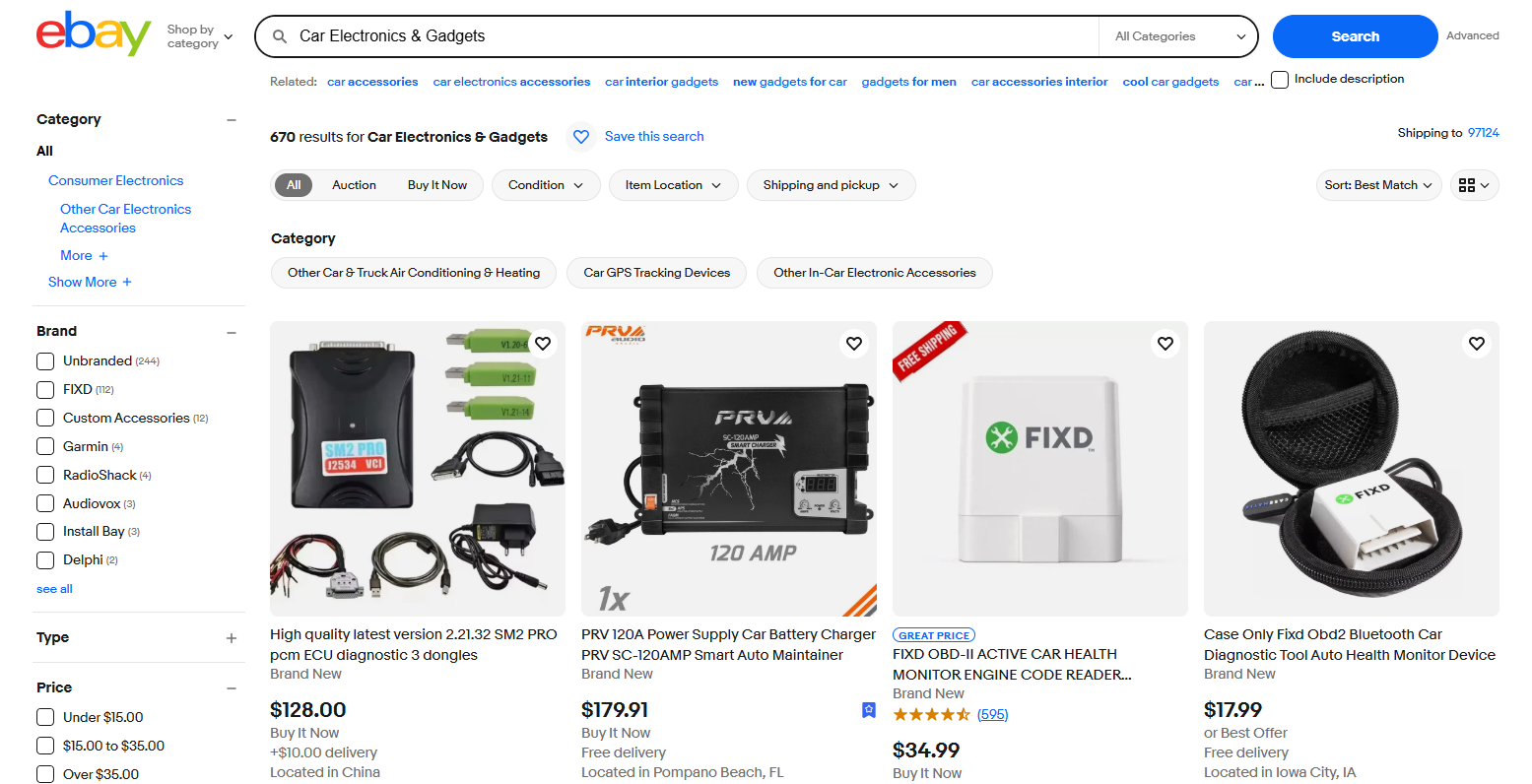
Modern drivers love tech upgrades. Dash cams, for example, have exploded in popularity for security and insurance reasons. Backup cameras and parking sensors are big sellers as aftermarket add-ons for older cars lacking those features. Then there are gadgets like OBD-II scanners (which let users read engine fault codes on their phone), head-up display units, Bluetooth kits, wireless phone chargers, and even in-car breathalyzers – all trending items in 2025. These electronic accessories are ideal for dropshipping: generally compact (cheap to ship), universally compatible or with broad appeal, and perceived as high-value by consumers. As newer tech comes out, there’s constant innovation driving new product opportunities. Pro tip: Emphasize features and compatibility (e.g. “works with all cars 1996 and newer” for OBD scanners) to reassure buyers.
5. Organizers and Convenience Accessories
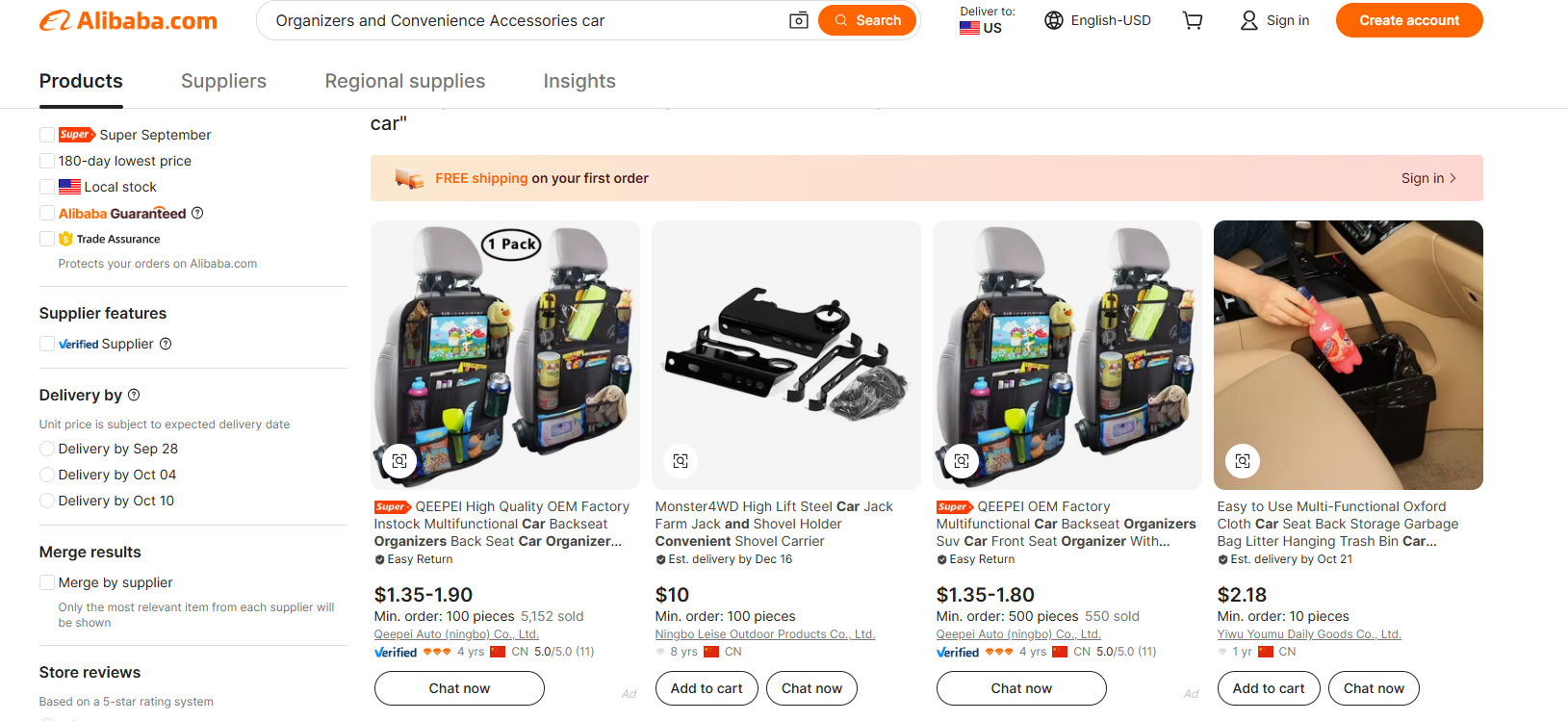
With people spending so much time in their vehicles, anything that adds convenience sells well. Car organizers – from trunk storage bins to backseat tablet holders and cup holder expanders – are inexpensive but popular, especially among families, rideshare drivers, and road-trippers. These items solve everyday problems (keeping the car tidy, entertaining kids, etc.). Other hot sellers in this category include phone mounts (dashboard or vent mounts for smartphones), USB charging adapters, and seat gap fillers (those clever inserts that keep items from dropping between the seats). Such accessories often cost only a few dollars wholesale but can sell for $15–20+, allowing a nice margin.
6. Exterior Upgrades (Lighting & Styling Kits)

Looks matter to many auto enthusiasts. LED lighting kits are a big trend – whether it's LED headlight bulb conversions, underglow light strips, or interior ambient lighting, drivers (especially younger ones) are customizing their vehicles’ look with lighting. You can also dropship window tint film kits, vinyl wraps or decals, and trim accessories (like blackout emblem kits or chrome delete kits) that let people cheaply modify their car’s appearance. These items are generally lightweight. Similarly, wind deflectors for windows, license plate frames, and other styling add-ons have steady demand. Just be mindful of local laws for items like tint and colored lights – but since you’re selling globally, there’s always a market somewhere for each product.
7. Performance and Aftermarket Parts
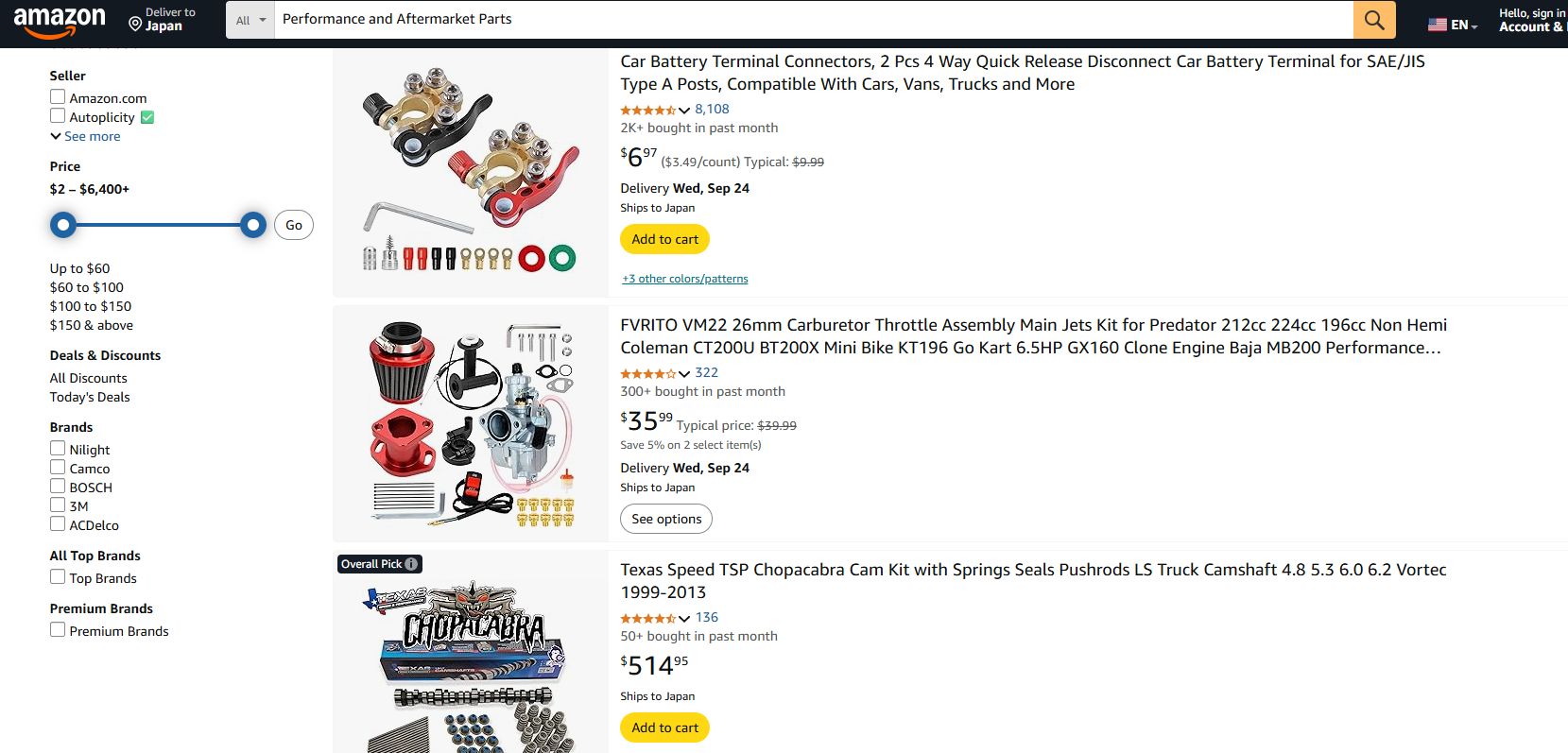
For the gearheads and hobbyists, aftermarket performance parts are the big-ticket niche. This includes things like cold air intake systems, performance exhaust kits, suspension upgrades (coilovers, lift kits), and turbocharger or engine tuning components. In 2025, there’s a continued rise in off-road vehicle mods (lift kits, off-road lighting, all-terrain tires) as well as street performance. While these items can be expensive and sometimes heavy, the customers are dedicated and willing to pay for specialty parts. If you go this route, you’ll likely work with specialized suppliers and may focus on a particular vehicle make or segment (e.g. “BMW performance parts” or “Jeep Wrangler upgrades”). The margin per sale can be excellent, but expect lower volume – these aren’t impulse buys but considered purchases. Still, dropshipping is a great way to offer a wide range of performance parts without tying up capital. Example: a performance exhaust retailing at $1000+ could net you a few hundred dollars profit in one sale. Just be prepared to handle customer questions (fitment, installation) or route them to the supplier for tech support.
8. Motorcycle and Powersports Accessories
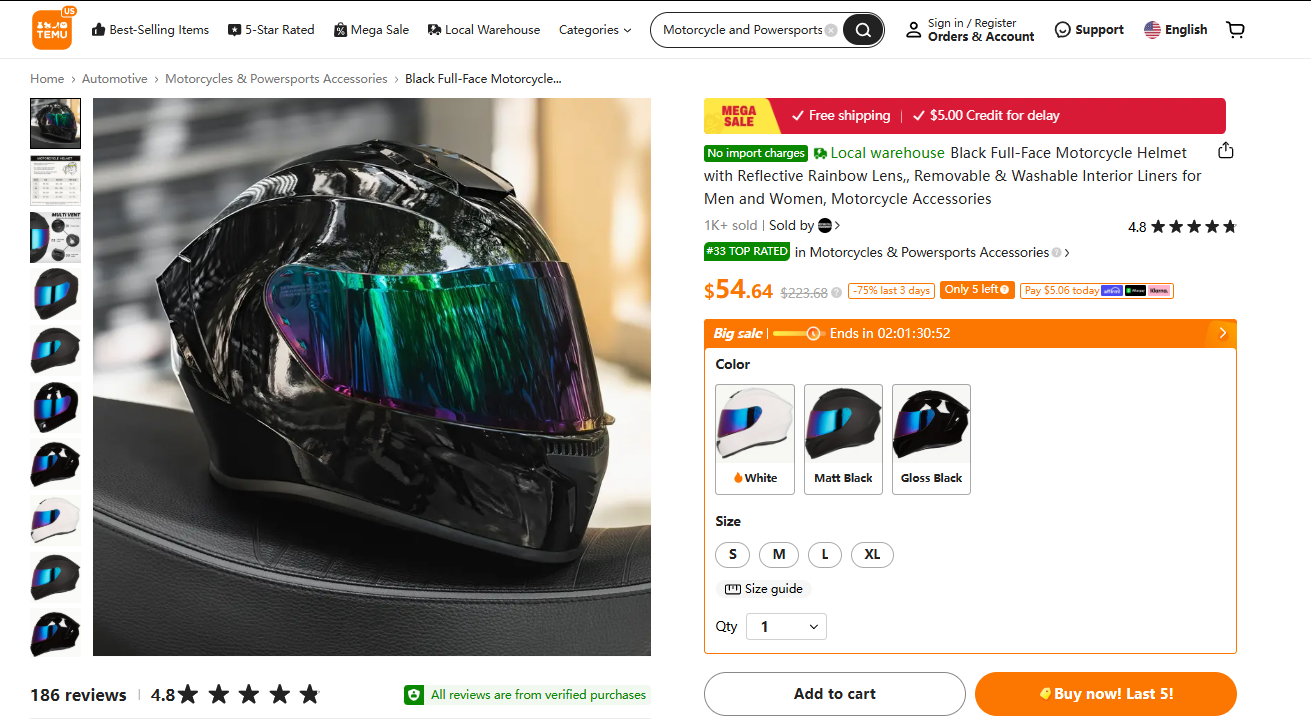
Don’t forget that “auto parts” can include motorcycles, ATVs, and more. Motorcycle accessories such as helmets, gloves, saddle bags, and LED light kits are strong niche products with a loyal customer base. Enthusiasts in this category often customize their bikes extensively, creating opportunities to sell specialty parts (aftermarket exhausts, custom handlebars, etc.) and gear. If you have a passion for bikes or connections to powersports suppliers, this niche can complement a car parts store or stand on its own. The key is to tap into communities of riders – they are often very active online and respond well to stores that cater to their specific style (sport bike, cruiser, off-road, etc.).
9. Tools and Repair Equipment
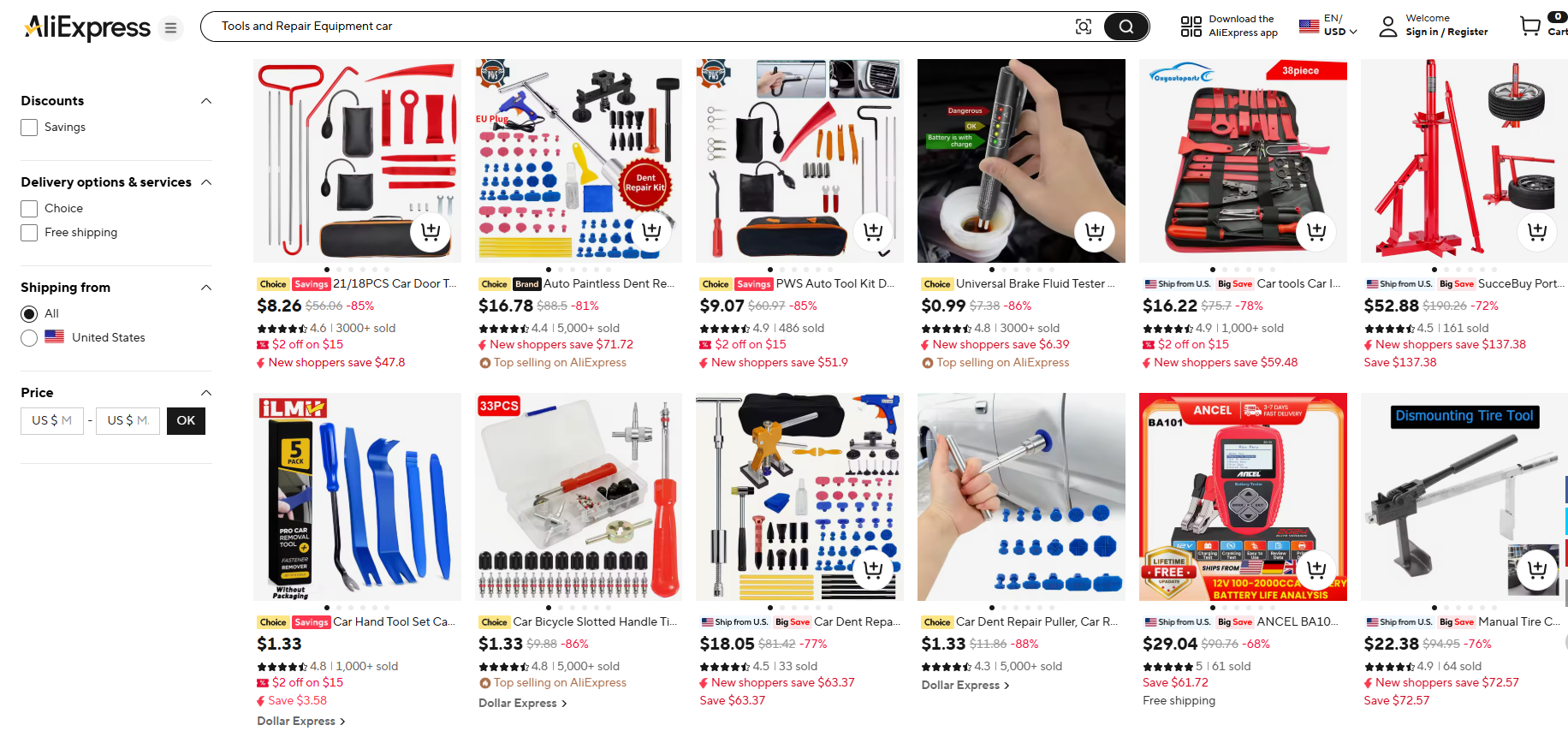
Many DIY customers buying parts will also need automotive tools or diagnostic equipment. Items like code readers (OBD-II scanners mentioned above), but also things like portable jump starters, battery chargers, tire inflators, and mechanic’s tool kits sell in high volumes. For instance, compact jump starter packs that can start a car battery and double as a power bank are extremely popular safety items, often purchased as gifts too. These tend to be easier to ship than car parts and have broad appeal (every driver could use one in their trunk). Consider upselling such tools alongside replacement parts – if someone’s buying brake pads, maybe they also need a brake bleeder kit or a torque wrench.
The list could go on (GPS navigation units for trucks, car cleaning and detailing kits for car care enthusiasts, and so forth), but the takeaway is: focus on products that are in high demand, not overly bulky, and preferably with decent markup potential. Data from recent years shows interior accessories and basic maintenance parts leading sales. Also, trends like vehicle infotainment upgrades and eco-friendly accessories (e.g. EV charging cables, if you cater to electric car owners) are worth watching.
When choosing products, leverage tools and research: check Amazon and eBay best-seller lists in automotive categories, see what competitors are featuring, and use dropshipping product research tools to spot trending items. Always verify that you can source a quality version of the part from a reliable supplier. Selling shoddy parts (especially critical ones like brake components) can lead to returns and unhappy customers – so quality control via supplier selection is key.
Finally, remember the fitment factor: many auto parts are vehicle-specific. If you list something like an alternator or a suspension part, be very clear about which make/model/year it fits. It’s often wise for new dropshippers to start with more universal items or accessories (which avoid the complexity of fitment). As you gain experience, you can expand into more specialized parts with proper fitment data on your site. This will minimize returns due to compatibility issues and keep customers satisfied.
Dropshipping Sourcing Strategies: OEM vs. Aftermarket vs. Accessories
When building an auto parts catalog, you’ll encounter different types of products and sources. The sourcing strategy for OEM parts vs. aftermarket parts vs. generic accessories can differ significantly. Here’s how they compare:
-
OEM Parts (Original Equipment Manufacturer): These are genuine parts made by the vehicle’s manufacturer (or its licensed supplier), identical to what came with the car when it was new. OEM parts are like precision-tailored pieces – they fit specific makes and models exactly as intended. Customers often trust the quality and compatibility of OEM parts the most. However, that confidence comes at a price. OEM parts tend to be more expensive because the brands invest heavily in R&D and quality control to meet strict standards. Car companies and OEM suppliers also build in a premium for the brand name. When dropshipping OEM parts, sourcing can be a challenge: you usually need to go through authorized distributors or dealer networks (e.g. use a wholesaler like a dealer’s parts department, or programs like Nissan or Ford’s official parts distribution if they allow online reselling). Margins on OEM parts might be thinner due to higher wholesale costs and competition from dealerships.
-
Aftermarket Parts: These are parts made by third-party manufacturers not affiliated with the car maker, intended to replace or upgrade OEM parts. The aftermarket is vast – it ranges from direct OEM-equivalent replacements (often at lower cost) to performance enhancements and custom parts. Independent aftermarket manufacturers often design parts to fit multiple models or replicate OEM specs without the branding. They don’t carry the automaker’s logo, but a good aftermarket brand can be as reliable. The big appeal here is cost-effectiveness and variety. Aftermarket parts are usually less expensive than OEM, which is attractive to cost-conscious shoppers and also means you, as the seller, can enjoy higher percentage margins. Because these companies skip the heavy R&D for each specific model and often use more generalized designs, they can price products competitively. From a sourcing perspective, aftermarket parts are easier to get – you can go through large distributors (like Keystone, mentioned above, which carries many aftermarket brands) or even direct from manufacturers at wholesale. There’s also a wider selection: you can find multiple aftermarket options for one OEM part, at different price points or performance levels. For a dropshipper, this means you can offer alternatives (good/better/best) and not be tied to one source. Aftermarket parts often yield higher profit margins because of the lower cost basis. Turnaround can be faster too, since these parts are widely available – you’re not waiting on a carmaker’s supply chain.
-
Accessories and Non-Essential Add-ons: We separate accessories because these are often neither OEM nor direct replacements, but rather products that enhance the car without being required parts. This category includes interior gadgets, organizers, aesthetic add-ons, tech devices, car care products, etc. Accessories are usually universal or semi-universal (one-size-fits-most) which simplifies your life – you don’t need an exhaustive parts compatibility database to sell a seat cushion or a car vacuum. Sourcing accessories is typically the easiest: there are countless manufacturers (especially in China, via CJdropshipping/AliExpress) and wholesalers that produce these items. You can also find domestic suppliers or niche brands for higher-end accessories. The strategy here: identify trending accessories and source them at low cost, then build compelling listings.
In practice, a well-rounded auto parts dropshipping business might incorporate all three categories: OEM for certain loyalist customers or specialty parts, aftermarket for the bulk of maintenance and upgrade parts, and accessories for volume and upsells. When starting out, many entrepreneurs lean into aftermarket and accessories because of easier sourcing and higher margins. You can then add select OEM items once you establish relationships or if you identify a particular demand (for instance, maybe you focus on one brand’s OEM parts if you find a supplier).
To source smartly:
-
Use multiple supplier types: Maybe a big distributor for mainstream parts, plus an AliExpress source for accessories, plus a niche supplier for performance parts. This covers your bases.
-
Verify supplier credentials for OEM: If someone claims to sell OEM Toyota parts, ensure they are legit (avoid counterfeit “OEM” items which can be common abroad – selling those can land you in legal trouble).
-
Leverage supplier inventory data: Good suppliers will provide you with spreadsheets or integrations so you know what’s in stock and can update your store. This is crucial especially for OEM/aftermarket parts with many variants.
-
Watch pricing and MAP policies: Some aftermarket brands enforce Minimum Advertised Price rules. Stay compliant if you carry those – tools exist to auto-update pricing if needed.
In summary, OEM parts offer premium quality at a premium price, best for a specialist approach; aftermarket parts offer value and variety, forming the core of most auto parts stores; and accessories offer broad appeal and high margins to spice up your catalog. By understanding these differences, you can craft a sourcing strategy that maximizes both sales and profits.
Fulfillment & Shipping: How to Handle Bulky/Heavy Parts
One of the unique challenges in the auto parts niche is that some products are large, heavy, or awkward to ship. Sending a set of spark plugs is easy – they’re small and lightweight – but what if someone orders a bumper or a set of tires?
1. Stick to small-to-midsize products (when possible). If you’re just starting out, a simple solution is curating your catalog to avoid very large parts. There is a reason many successful dropshippers focus on accessories and smaller components – they’re cheaper to ship, less likely to get damaged in transit, and easier to handle for both you and the customer.
2. Optimize your shipping partnerships. When you do sell heavy parts (engines, transmissions, large body panels, wheels, etc.), standard postal shipping may not cut it. These often ship as freight (LTL – less than truckload – on pallets) or require specialty couriers. If you anticipate selling such items regularly, align with suppliers or third-party logistics (3PL) companies that specialize in auto parts. Some suppliers will drop ship heavy items for you using their freight accounts, which is ideal.
3. Use multiple warehouses or local suppliers. Shipping cost is heavily dependent on distance. If all your suppliers are in Asia but your customers are in the U.S., a heavy package will be painfully expensive to air ship and slow by sea. One strategy is to work with suppliers that have regional warehouses. For example, some CJdropshipping suppliers stock inventory in California or New Jersey for U.S. distribution – use those for U.S. orders to cut transit time and cost.
Best Strategies for Auto Parts Dropshipping
Running a successful auto parts dropshipping business in 2025 requires more than just picking good products. It takes smart strategies in marketing, customer service, and store optimization.
-
Carve Out Your Niche (Don’t Be a Generalist): The automotive market is gigantic; you’ll do better by focusing on a subset that you can master. Perhaps it’s off-road truck accessories, or European luxury car parts, or even just car lighting products.
-
Ensure an Excellent Website Experience: Auto parts shoppers often have specific needs – make sure your online store helps them find the right product easily. This means implementing robust search and filtering tools, especially a vehicle compatibility search (by year/make/model) if you sell parts that depend on that. Nothing frustrates customers more than not knowing if a part fits their car. Provide compatibility charts, or use apps/integrations that let users input their vehicle and see matching parts.
-
Partner with Reliable Suppliers (and Have Backups): We touched on supplier selection earlier, but as a strategy: supplier reliability is the backbone of your business. If a supplier has erratic stock or slow shipping, your customers will feel it. Do your homework when onboarding suppliers – check reviews or ask for references, place some test orders to see their packaging and speed, and communicate expectations.
-
Optimize Pricing and Offer Value: The auto parts space can be competitive (customers often price-check parts). Take advantage of the dropshipping model’s low overhead to price competitively and still profit. If your costs are lower than a local store, you can pass some savings to the customer. Also consider offering free shipping for orders above a certain value, or bundle discounts – these can increase average order size and improve customer satisfaction.
-
Invest in Paid Advertising (Smartly): Given the profitability of many auto parts, paid ads can be a great way to drive traffic – if done right. Google Shopping ads are powerful in this niche: many people will search a specific part and see Shopping results. Ensure your products are listed there, and tweak your bids for key items.
-
Utilize Automation Tools: Managing an auto parts store can get complex – lots of SKUs, stock updates, price changes, etc. Embrace software tools to automate wherever possible. Inventory and order management systems can sync stock levels from suppliers, push orders to them automatically, and update tracking numbers to customers. This reduces manual errors and frees your time. Tools like CJdropshipping, AutoDS, or inventory management plugins can be integrated into your store.
How to Start Your Auto Parts Dropshipping Business: A 5-Step Guide
Ready to shift gears from planning to action? Here is a 5-step roadmap to launching your own auto parts dropshipping business, even if you’re a complete beginner:
1. Research and Define Your Niche – Start by deciding what segment of auto parts or accessories you will focus on. The auto market is too broad to tackle all at once, so narrow it down. Research current trends and gaps: is there a high demand for something not well-served online? You might choose a niche based on vehicle type (e.g. parts for classic cars, or 4x4 off-road accessories), based on product category (e.g. only automotive lighting, or car audio equipment), or based on customer segment (e.g. DIY mechanics, or luxury car owners). Use tools and market research: Google Trends, Amazon bestseller lists, and even forums/social media can clue you in to popular items.
2. Find Quality Suppliers and Products – With your niche determined, the next step is securing the supply side. Look for suppliers that carry the products you want and offer dropshipping services. You have a few avenues:
-
Use supplier directories or platforms: Websites like CJdropshipping, AutoDS, or Inventory Source can help find dropship suppliers in automotive categories. For example, CJdropshipping has vetted US/EU auto accessory suppliers.
-
Contact distributors/wholesalers: If you identified specific brands or parts, reach out to their official distributors. Many traditional auto parts wholesalers (e.g. Turn 14, Keystone) will work with online retailers – you may need to apply for a dealer account. This often requires a business license or tax ID (so be prepared to set up a legal business). The upside is access to large catalogs and possibly better pricing.
-
AliExpress/Alibaba manufacturers: If you’re focusing on accessories or generic parts, you can source directly from manufacturers on AliExpress or Alibaba. Look for those with good ratings and communication. Order samples to verify quality.
-
Retail dropshipping (careful): Some dropshippers use retailers like Walmart, Amazon, or eBay as sources (buy at retail and ship to customer). While possible, this is generally less sustainable – margins are thin and there’s risk of order cancellation. It’s best used as a backup or for uncommon parts you can’t find wholesale.
-
Local auto parts stores: In some cases, even local parts stores or dealerships might drop ship for you if you arrange it (or you can manually place orders with them to fulfill). This is more hands-on and usually not scalable, but could fill gaps.
3. Set Up Your Online Store – Now, create the storefront where customers will actually buy. Many entrepreneurs opt for Shopify as it’s user-friendly and has tons of dropshipping apps, but you could use WooCommerce (WordPress), BigCommerce, or others – choose what you’re comfortable with. Key steps in setting up:
-
Choose a theme/design: Go for a clean, professional look. There are automotive-themed templates out there. Ensure the navigation menu logically covers your product categories.
-
Install necessary plugins/apps: If on Shopify, you might add an app for vehicle fitment search (some apps let you add that Year/Make/Model filter functionality). Install your dropshipping integration app (for example, if you use CJdropshipping to integrate with Shopify, get that set up). If your supplier provides a product feed, import those products via a CSV or API connection. Also consider apps for reviews (displaying product reviews can boost trust), live chat, and SEO optimization.
-
Add product listings: Create pages for each product with descriptive titles (include part name and applicable cars or keywords), detailed descriptions, specs, and high-quality images. If possible, add PDFs of installation instructions or compatibility lists – these are gold for customer confidence. For parts, also list the manufacturer brand and part number. This not only helps customers validate the part, but also improves your SEO for people searching that part number.
-
Set up pages and policies: Create an About Us (tell the story of your niche expertise), Contact Us (provide an email, maybe a phone if you can handle calls, or at least a contact form), Shipping Info, Return Policy, and FAQ page. Having these well-written and accessible makes your store look legitimate and answers common questions upfront.
-
Configure payments and checkout: Connect a payment gateway (PayPal, credit card processor, etc.) so you can accept payments securely. Test the checkout process end-to-end (place a test order and see if everything flows).
-
Search functionality: As emphasized, if you sell many parts, implement a Year/Make/Model filter or at least a robust search bar. Shopify may need a third-party app for this; WooCommerce has plugins for it. This feature can be the difference between a user finding the exact part they need or leaving in frustration.
-
Mobile optimization: Check your site on a phone. Auto parts info can be table-heavy (like fitment tables), so ensure it’s still readable. Many DIY folks might be in the garage on a phone checking something, so this is critical.
Building the store might take some time, but it’s crucial to get it right. Don’t rush launch until core elements are in place – a sloppy site can turn away the hard-earned visitors you drive to it.
4. List Products and Streamline Fulfillment – With the shell of the site ready, finish populating your product catalog and set up how orders will flow to suppliers.
-
Upload your curated product selection: Whether manually or via an app, make sure each product you intend to sell is live on the site with correct pricing. Set your pricing strategy (e.g. 2x markup or more on cost for most items, maybe lower markup on very expensive items). Double-check variants – if a part has multiple sizes or colors, are they all listed? If using an app like Oberlo, DSM Tool, etc., verify that the sync is working (so stock levels will update).
-
Set up shipping settings: Decide how you charge shipping. You might do free shipping on all, or tiered by weight/price, or real-time carrier rates. For simplicity, many dropship stores do free shipping and just factor the cost into prices, or free shipping over a certain dollar amount. Make sure to account for heavy items – you might need a separate rule for, say, items over 20kg (like “Heavy Item Freight – $50 flat rate” or something) if your platform allows it. The goal is you don’t want an order to come in for a heavy bumper and your site only charged $5 shipping. So configure those carefully.
-
Automate order forwarding: Set up your system so that when an order comes in, you can quickly send it to the supplier for fulfillment. This could be as simple as an email to the supplier (some smaller suppliers work via email orders), or as advanced as full API integration. If using a dropship platform like CJdropshipping, configure the connections to each supplier – test by pulling an inventory update or placing a draft order. Ensure you’ve input your supplier account credentials or API keys correctly. The smoother this process, the faster customers get tracking info.
By the end of this step, you should have a fully functional store with products displayed and a system to fulfill any orders that come in.
5. Launch, Market, and Continuously Improve – Time to open the doors and get some traffic. Launching isn’t the end – it’s the beginning of a continuous process of marketing and optimization.
-
Announce your launch: If you have social media accounts or a mailing list (maybe you built some pre-launch hype in enthusiast groups), announce that your store is live with a limited-time promo (e.g. “Grand Opening – 10% off first purchase for the next 7 days!”). Early incentives can help get those crucial first orders through.
-
Drive targeted traffic: Utilize the marketing channels that make sense for your audience. For auto parts:
-
SEO: This is a longer-term play, but start building it now. Optimize your product page keywords, start writing blog posts (as discussed in strategies above), and get backlinks by perhaps partnering with automotive bloggers or submitting your site to directories.
-
Pay-Per-Click Ads: Google Ads targeting specific part keywords (“buy [part] online”) can capture high-intent buyers. Also consider Google Shopping ads for your products. Set a modest budget and refine as data comes in. On social media, run Facebook or Instagram ads if the product is visual/impulse-friendly (accessories, mods). Use targeting options like car make/model interests if available.
-
Social Media & Community: Create profiles on platforms popular with your niche (Facebook page, Instagram showcasing product pics, maybe TikTok if you can make fun car mod videos). Regularly post content – not just promotions, but useful or entertaining stuff (memes for car lovers, short tips, showcase customer rides using your products, etc.). Engage in Reddit or car forums (without spamming – provide value, then people naturally check your store via your profile or occasional mention).
-
-
Gather reviews and testimonials: Social proof will help future sales. Encourage happy customers to leave a review on your site (make it easy with a review app link) or share a photo of the part installed, maybe by offering a small coupon in return. Build a testimonials section – “Joe S. from California says: These guys had the best price on my BMW radiator and shipping was super fast!” This alleviates concerns for new visitors.
-
Analyze and refine: Use the analytics tools you set up to see what’s working. Maybe you find that a particular blog post is bringing a lot of traffic – consider writing more on that topic or improving the internal links to products from it. Perhaps Google Ads show one product gets tons of clicks but no sales – maybe its price is too high or the product page needs more info to convert. Be ready to tweak things like pricing, site layout, or marketing spend allocation. Dropshipping businesses, especially in competitive niches, require ongoing optimization. Look at your conversion rate, bounce rate, and cart abandonment metrics. If many people add a certain part to cart but abandon, investigate why (shipping cost surprise? unclear return policy?).
-
Expand your catalog gradually: Once the initial setup is humming, you can scale up product count. Add products that complement those selling well. If “floor mats for sedan X” are a hit, maybe add trunk liners or window deflectors for that same car model. Use supplier data to expand logically rather than adding random items. Each new product is another opportunity to attract or upsell a customer.
Launching an auto parts dropshipping store is a significant effort, but by following these steps you break it into manageable pieces. To recap: research deeply, secure great suppliers, build a user-friendly store, streamline your fulfillment, and then market aggressively and smartly. With dedication, you’ll start seeing orders roll in. From there, treat every customer well and iterate on your business. Over time, you can grow this into a serious e-commerce venture. Many big auto part retailers online today started small in exactly this way – the difference is consistency and continuous improvement.
FAQ for Auto Parts Dropshipping
1. Is dropshipping auto parts profitable?
Yes, dropshipping auto parts can be highly profitable when done correctly. Auto parts and accessories are always in demand – there’s a huge, evergreen market of drivers who need replacements or upgrade. Because many parts have relatively high price points, the profit per sale can be good.
2. Can I legally dropship car parts, and do I need any special permits?
Dropshipping car parts is legal and follows the same laws as any retail business. You typically do not need a special license just to sell generic auto parts. However, you should register a business and obtain any general business licenses or sales tax permits required in your jurisdiction (for example, in the U.S. you’d want a resale certificate to buy from wholesalers tax-free). The main legal caution is to avoid counterfeit or trademark-infringing products.
3. Do I need to be a car expert or mechanic to dropship auto parts?
No, you don’t need to be a certified mechanic, but having some automotive knowledge is definitely helpful. You should familiarize yourself with the basics of the products you sell – for instance, knowing that brake pads have wear indicators, or that LED headlight bulbs might need specific fitment. Understanding your niche (be it performance tuning or car care or general repair parts) will help you answer customer questions accurately.
4. What are the best platforms for dropshipping auto parts?
The best platforms for dropshipping auto parts include Shopify, WooCommerce, and BigCommerce, as they offer flexibility, integration with reliable suppliers, and tools to manage inventory and orders. Shopify is beginner-friendly with many dropshipping apps, WooCommerce is ideal if you already use WordPress, and BigCommerce provides scalability for larger stores. Choosing the right platform depends on your budget, store size, and the level of customization you need.
5. Are there auto parts dropshippers with fast shipping in the USA?
Yes, several auto parts dropshippers offer fast U.S. shipping, helping reduce delivery times and improve customer satisfaction. Companies like CJdropshipping, AutoZone suppliers, and U.S.-based warehouses on Spocket provide quick shipping options. Working with U.S. suppliers allows you to avoid long overseas delivery times and ensures faster fulfillment, often within 2–7 business days. This makes your dropshipping store more competitive while keeping customers happy with reliable shipping

